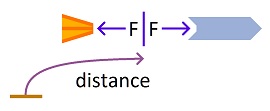 |
|
Gary Novak
Background
|
2. Rocket Analysis Rocket Equations The rocket equations which physicists use, based upon ½mv², show a constant power, because it equals a constant force times a constant velocity—the separation velocity of the exhaust. But the total power is nothing but a mathematical abstraction which cannot be located with a mass.
The equations are shown below. The method of determining force is the same by either definition, as is acceleration and velocity. The rocket described will then be applied to the falling object issue (see falling object page) demonstrating the logic and showing the proof. x' = rate of change for x = dx/dt (' is rate of change) mo = mass of rocket at start = 20kg plus payload (21 or 24 kg) m' = rate of mass loss = -0.01kg/s mt = mass of rocket at time T = mo + m't ve = separation velocity of exhaust = 103m/s (pos) F = force = -m've = -(-0.01)(103) = 10 newtons v't = acceleration at time T = F/mt v = velocity = ∫ v'dt = ∫ 10/(mo - 0.01t)dt = ∫ 103/(100mo - t)dt = -103ln(100mo - t) + c (-c is quantity at T = 0)by erroneous definition of energy: KE'r = power of rocket = mv'v + ½m'v2 KE'e = power of exhaust = -½m'(v - ve)2 KE'total = total power = KE'r + KE'e = -½m've2 in all cases: -½(-0.01)(103)2 = 5x103 (For math explanations, click here.) The power curves for the rocket mass and exhaust mass (with the erroneous definitions) are always mirror images, because they equal a constant total. When reference frames shift, the power of each changes, while the total stays constant. So there is not a consistent power for either mass. The basic rocket equations were provided by the Jet Propulsion Laboratory. The velocity equation was derived independently.Rocket Applied to Falling Objects for Proof The rocket is used to determine the amount of energy in the falling objects by attaching the masses and accelerating up to the required velocities. The amount of burn time for the rocket is determined. Time represents fuel use, since fuel is used at a constant rate. When the 4kg mass is attached, about 1/6 of the energy is attributed to it, since the rocket mass is 20kg. For the 1kg mass, about 1/21 of the energy is attributed to the attached mass. However, these fractions need to be corrected slightly, because the rocket mass changes as fuel is used. The adjusted fraction is the attached mass divided by the total starting mass (m0) minus one half the exhaust mass, which represents the average mass. The exhaust mass equals burn time times rate of mass loss. Actually, the average should be a little less than half, but dividing by two is a very close approximation, which is adequate for the purpose. An exact procedure is shown on the explanation page. Averaging is done here to create the clearest possible logic, so someone doesn't assume I'm pulling the wool over their eyes. Here is the formula for the time of burn for the rocket as derived from the velocity equation. It is tailored in form and sequence for a calculator.
Leibniz stated that a 4kg object dropped 1m would have the same energy as a 1kg object dropped 4m. The 4kg mass acquired a velocity of 4.429447m/s. So the rocket will be accelerated up to that velocity and the burn time required will be calculated as an indication of the energy used. Then the same will be done with the 1kg mass, which had a velocity of 8.858894m/s. m1 = 4kg v = 4.429447 m0 = 24kg c = 7,783.224 t = 10.6072 fraction = 4/[24 - 0.01(10.6072)/2] = 0.167036 time for 4kg = 0.167036(10.6072) = 1.77178 seconds m2 = 1kg v = 8.858894 m0 = 21kg c = 7,649.6926 t = 18.5215 fraction = 1/[21 - 0.01(18.5215)/2] = 0.0478300 time for 1kg = 0.0478300(18.5215) = 0.885883 time ratio for two masses: (equals energy ratio) 1.77178/0.885883 = 2.000 (Proof it's not ½mv²) The ratio of 2.0 shows that twice as much time was required to accelerate the 4kg mass; and therefore, twice as much fuel was used. Yet they were supposed to have the same energy in the Leibniz analysis and existing concepts, because they had the same ½mv² (39.2, as shown earlier). Since the 4kg mass had twice as much momentum, the result demonstrates that the fuel transformed in proportion to the momentum rather than the ½mv².
Now the momentum test will be analyzed. The 4kg mass was dropped for 1 second, and the 1kg mass was dropped for 4 seconds. The burn time for the rocket determines their energy. m1 = 4kg v = 9.810000 m0 = 24kg c = 7,783.2240 t = 23.4289 fraction = 4/[24 - 0.01(23.4289)/2] = 0.167484 time for 4kg = 0.167484(23.4289) = 3.92397 seconds m2 = 1kg v = 39.240000 m0 = 21kg c = 7,649.6926 t = 80.8082 fraction = 1/[21 - 0.01(80.8082)/2] = 0.0485532 time for 1kg = 0.0485532(80.8082) = 3.92350 time ratio for two masses: (equals energy ratio) 3.92397/3.92350 = 1.000 (Proof it's mv) The ratio of 1.0 shows that the same amount of time was required for both masses resulting in the same amount of fuel being used. So two masses which had the same momentum required the same amount of additional fuel to be used by the rocket. Yet the ½mv² of one was four times larger than that of the other (770 for the 1kg mass, and 192 for the 4kg mass) (See Falling Objects). The Conclusion In other words, the fuel of a rocket is transformed in proportion to the momentum of the mass being accelerated. Even though physicists can balance equations when defining energy as ½mv², there are no logical relationships between concepts, and the energy is not located in a mass but is nothing but a mathematical abstraction. |
